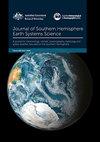影响中国大陆和澳大利亚的大气河流:气候学和年际变化
IF 3.6
4区 地球科学
Q1 Earth and Planetary Sciences
引用次数: 12
摘要
在本研究中,我们利用日本55年的人工再分析数据,建立了中国大陆和澳大利亚的两个大气河(AR)数据库。通过人工核对再分析资料计算的垂直整合水汽输送场的大小、形状和方向,并分析其嵌入的天气模式和其他气象信息,我们发现1986-2016年中国大陆发生了625次AR事件,1977-2016年澳大利亚大陆发生了576次AR事件。本文记录了这两个地区的平均气候学、空间分布、季节性和年际变化。我们还评估了可能影响AR活动的潜在驱动因素。结果表明:(1)中国大陆上空的ar主要发生在中国南部、东部和中部的低纬度地区,但ar也到达中国大陆的远北部和东北部地区。在澳大利亚,大多数ar发生在西澳大利亚州、南澳大利亚州以及新南威尔士州和维多利亚州的部分地区。这些高AR频率区域在凉爽季节也经常出现西北云带;(ii)东亚夏季风季(5 - 9月)是中国ar的高峰。这也是澳大利亚地区AR频率较高的时期,但其季节变化弱于中国;(三)两区域的农业生产总值年际变化较大,中东部呈下降趋势;(四)热带海表温度对区域内的AR活动有显著影响,其中澳大利亚的AR特别受到印度洋海表温度和热带太平洋El-Niño南方涛动(ENSO)的影响。中国的ar似乎受到ENSO衰减阶段的影响,在其前一个冬季厄尔尼诺峰值之后的北方夏季可能发生更多ar;(5)西太平洋副热带高压在中国副热带气旋主要水汽输送通道的形成中起主导作用,南海是主要水汽来源。在澳大利亚地区,来自热带印度洋东部的暖湿空气对该大陆西部的ar起着重要作用。此外,来自珊瑚海地区的水汽输送是其东部ARs的重要水汽来源。这项研究的结果证明了使用AR诊断来更好地理解A-A地区气候变化的控制过程的价值。本文章由计算机程序翻译,如有差异,请以英文原文为准。
Atmospheric rivers impacting mainland China and Australia: climatology and interannual variations
In this study we have built two atmospheric river (AR) databases for mainland China and Australia using Japanese 55-year Reanalysis data with manual detections. By manually checking the magnitude, shape and orientation of vertically integrated vapour transport fields calculated from the reanalysis data and analysing its embedded synoptic patterns and other meteorological information, we detected 625 AR events over mainland China during 1986–2016 and 576 AR events over the Australian continent during 1977–2016. This manuscript documents the mean climatology, spatial distributions, seasonality and interannual variations of ARs occurring in these two regions. We also assessed possible underlying drivers influencing AR activities. Our results showed that: (i) most ARs over mainland China occured in its lower latitudes, including southern, eastern and central China, but ARs also reached its far north and northeast regions. In Australia, most ARs occurred in the states of Western Australia, South Australia and part of New South Wales and Victoria. These regions of high AR frequencies also frequently experienced Northwest Cloud Bands during the cool season; (ii) ARs in China reached their peak during the East Asian summer monsoon season (May–September). This was also the period when AR frequency in the Australian region tended to be higher, but its seasonal variation was weaker than in China; (iii) ARs exhibited large interannual variations in both regions and a declining trend in central and eastern China; (iv) there was a notable influence of tropical sea surface temperatures (SSTs) on the AR activities in the region, with the ARs in Australia being particularly affected by Indian Ocean SSTs and El-Niño Southern Oscillation (ENSO) in the tropical Pacific. ARs in China appear to be affected by ENSO in its decaying phase, with more ARs likely occurring in boreal summer following a peak El Nino during its preceding winter; (v) the Western Pacific Subtropical High plays a dominant role in forming major moisture transport channels for ARs in China, and South China Sea appears to be a key moisture source. In the Australian region, warm and moist air from the eastern part of the tropical Indian Ocean plays a significant role for ARs in the western part of the continent. In addition, moisture transport from the Coral Sea region was an important moisture source for ARs in its east. Results from this study have demonstrated the value of using AR diagnosis to better understand processes governing climate variations in the A–A region.
求助全文
通过发布文献求助,成功后即可免费获取论文全文。
去求助
来源期刊

Journal of Southern Hemisphere Earth Systems Science
Earth and Planetary Sciences-Oceanography
CiteScore
8.10
自引率
8.30%
发文量
0
审稿时长
>12 weeks
期刊介绍:
The Journal of Southern Hemisphere Earth Systems Science (JSHESS) publishes broad areas of research with a distinct emphasis on the Southern Hemisphere. The scope of the Journal encompasses the study of the mean state, variability and change of the atmosphere, oceans, and land surface, including the cryosphere, from hemispheric to regional scales.
general circulation of the atmosphere and oceans,
climate change and variability ,
climate impacts,
climate modelling ,
past change in the climate system including palaeoclimate variability,
atmospheric dynamics,
synoptic meteorology,
mesoscale meteorology and severe weather,
tropical meteorology,
observation systems,
remote sensing of atmospheric, oceanic and land surface processes,
weather, climate and ocean prediction,
atmospheric and oceanic composition and chemistry,
physical oceanography,
air‐sea interactions,
coastal zone processes,
hydrology,
cryosphere‐atmosphere interactions,
land surface‐atmosphere interactions,
space weather, including impacts and mitigation on technology,
ionospheric, magnetospheric, auroral and space physics,
data assimilation applied to the above subject areas .
Authors are encouraged to contact the Editor for specific advice on whether the subject matter of a proposed submission is appropriate for the Journal of Southern Hemisphere Earth Systems Science.
 求助内容:
求助内容: 应助结果提醒方式:
应助结果提醒方式:


